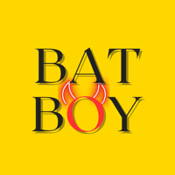
Overview
Synopsis
Bat Boy: The Musical was inspired by a series of tabloid headlines published in 1992 by The Weekly World News claiming that a terrifying creature, half-man and half-bat, had been discovered in a cave, escaped, and was being pursued by government officials. In Farley, Flemming, and O’Keefe’s musical rendering of the story, a group of spelunking West Virginian teenagers discover the creature near Hope Falls. For lack of a better solution, the sheriff brings him to the local veterinarian (Dr. Parker’s) home, where he begins to assimilate to human life and become a part of the Parker family while trying to keep his penchant for sucking human blood under control. Meredith, Dr. Parker’s wife, and Shelley, his daughter, become increasingly close with the creature, whom they name Edgar, while Dr. Parker becomes more and more wary of his assimilation into the human world. When Edgar tries to ingratiate himself with the townfolk of Hope Falls, he is quickly rejected, and he and Shelley (who fall in love) run away together. After a single night of joyous freedom, tragedy strikes when Meredith finds them and reveals the dark secret of Bat Boy’s origin. With a beat-driven rock score that pays homage to the rock musicals of the late ‘60s and early ‘70s, Bat Boy provides a compelling theatrical metaphor for the dangers of prejudice, intolerance, and provincialism.
Show Information
Context
Bat Boy: The Musical emerged from the late 1990s Los Angeles theatre scene, where experimental companies were blending pop culture parody with serious social commentary. Writers Keythe Farley and Brian Flemming, along with composer Laurence O’Keefe, drew inspiration from a sensational tabloid article in Weekly World News about a half-human, half-bat creature allegedly discovered in a West Virginia cave. Rather than play the story as pure camp, the creative team used it as a vehicle for
to read the context for Bat Boy and to unlock other amazing theatre resources!Plot
Characters
| Name | Part Size | Gender | Vocal Part |
|---|---|---|---|
|
Lead |
Female |
Mezzo-Soprano |
|
|
Lead |
Male |
Tenor |
|
|
Lead |
Male |
Tenor |
|
|
Lead |
Female |
Soprano |
|
|
Featured |
Male |
Baritone |
|
|
Featured |
Male |
Tenor |
|
|
Featured |
Male |
Baritone |
|
|
Featured |
Female |
Mezzo-Soprano |
|
|
Mrs. Taylor / Roy / Reverend Billie Hightower / Institute Man |
Featured |
Male |
Tenor |
|
Featured |
Male |
Tenor |
|
|
Ensemble |
Either or Both |
|
Songs
Act I
Act II
A song with an asterisk (*) before the title indicates a dance number.
Monologues
Scenes
Key Terms
Allegory is a storytelling device in which characters, events, and settings represent abstract ideas or moral qualities. In theatre, allegorical plays often deliver social, political, or religious messages beneath their surface narrative.
Camp is a performance style that celebrates exaggeration, theatricality, and deliberate bad taste for comic or satirical effect. Often marked by irony, flamboyance, and over-the-top characterizations, camp turns the absurd into entertainment. In theatre, it invites audiences to laugh both at and with the performance’s outrageousness.
A genre that combines elements of humor and morbidity, exploring serious themes through satire or irony.
A literary and dramatic style emphasizing horror, emotion, and the supernatural. This term plays a vital role in understanding theatrical structure and is commonly encountered in stagecraft or performance settings.
Grotesque refers to a style of theatre that blends the bizarre, distorted, or monstrous with comic or sympathetic elements. It often exaggerates physical or emotional traits to provoke both laughter and discomfort in audiences. In drama, the grotesque highlights the strange or unsettling while still revealing human vulnerability and truth.
A dramatic genre with exaggerated characters and emotions, often including music to enhance moral and emotional stakes.
Parody is a comedic imitation of a style, genre, or work that exaggerates its features for humorous or satirical effect. In theatre, it playfully mocks conventions, characters, or cultural icons while still relying on audience recognition of the original. Parody can both celebrate and critique its subject, often blurring the line between homage and ridicule.
A rock musical is a form of musical theatre that incorporates the rhythms, instrumentation, and energy of rock-and-roll into its score. Emerging in the late 1960s with shows like Hair, rock musicals often bring a contemporary, rebellious edge to the stage. They blend theatrical storytelling with the raw power of popular music to attract younger and more diverse audiences.
Satire is a dramatic style that uses humor, irony, and exaggeration to criticize human behavior, social institutions, or political systems. In theatre, it highlights flaws and hypocrisies through wit and parody, encouraging audiences to laugh while also reflecting on serious issues. Satire can range from lighthearted comedy to biting social commentary, making it both entertaining and thought-provoking.
Videos
Quizzes
Sorry! We do not currently have quizzes for this guide.
Themes, Symbols & Motifs
Themes
Prejudice and Fear of the Other – The
to read about the themes, symbols and motifs from Bat Boy and to unlock other amazing theatre resources!Quote Analysis
Sorry! We do not currently have learning modules for this guide.
